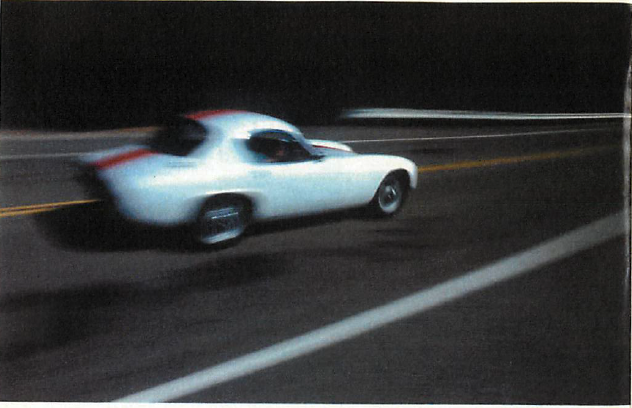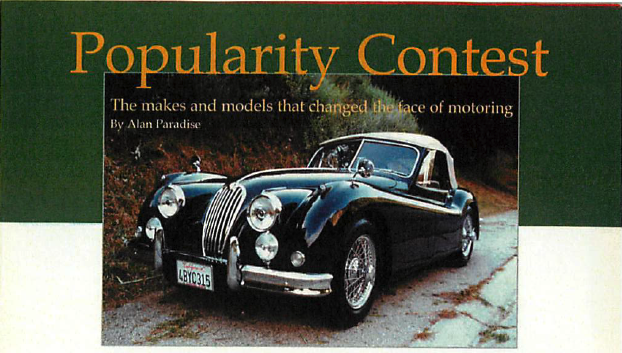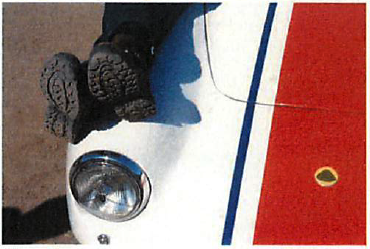Lotus changes the nature of exotic supercars
By Wiley Davis
The business card that Mike Ostrov hands to me is a focused peek into his personality. He presents it upside down, revealing a backside stamped with the words “Club Elite” just below an outline of a Lotus Elite profiled in red ink. Out of curiosity I turn it over to see what this man does for a living.
Judging by the hobby garage he maintains in a quiet backwater outside San Francisco, it is difficult imagining him having an actual occupation. Unless tinkering with vintage Lotus automobiles while drinking beer can be considered a job, Mike seems to be unemployed. When I first talked to him on the telephone I cautiously asked for permission to photograph the Elite I heard he owned.
“Which one?” he asked.
“I didn’t know you had two,” I said.
“I don’t,” he countered. “I own four…that are running. I also have a Lotus Seven and a really expensive tie-rack.”
“What colors are they?”
“I’ll tell you what. Can you drive a stick?”
“Yes.”
“Good. If you know anyone else that can drive a stick we’ll take the lot of them out for a drive and you can take as many pictures as you’d like.”
Two days later I am standing outside a small garage with a gravel driveway. A green Lotus seven is poking its nose into the sun through the open garage door. Mike has come out with a handshake and a grin. The front side of his business card, I notice as he chats up my girlfriend, showing her some oddity on the Seven, says that Mike was a certified financial planner in his days before retirement. I scan the details and notice that just below the phone numbers for the office and fax machines (crossed out with black pen) is a string of digits labeled “Shop Phone.” This simple rectangle of cardboard accurately classifies Mike Ostrov’s priorities. I am guessing that not much “financial planning” was done at the shop.
This zealous devotion is fitting for the owner of a Lotus. If it were not for zealousness, Lotus would not even exist. Colin Chapman was all things to the company. He was a masterful engineer that revolutionized the racing world. He is a god among young engineers. The student Society of Automotive Engineers (SAE) is filled to capacity with college students who worship Colin Chapman as if he were Michael Jordan. Perhaps a better comparison, however, would be Dennis Rodman. Colin always did things differently. He was responsible for popularizing the mid-engine layout and the monocoque chassis. He was a fanatic about weight. All Lotus cars are lightweights. The Elite boasts a running weight of 1525 lbs. This is an average number for a street automobile, not a special factory “lightweight” version. The Lotus Seven is more of a feather at 1200 lbs., with race-prepped cars sometimes approaching the 800 lb. mark. The Lotus reputation, and soul, is based on engineering. The Italians have sultry design and fiery passion, the Germans have craftsmanship and perfection, the English have—with Lotus as the flagship—an odd brew of engineering excellence, spotty design and absolutely no craftsmanship. It is, completely, a reputation that fits a fanatical tinkerer like a glove.
Lotus and Colin built their reputations on a foundation of racing successes. But Colin was resolved to establish Lotus as a manufacturer of upper echelon GT cars, not just racing machines. Out of this desire, the Elite was born.
The Lotus Seven had been a consumer car, technically, but it was by no means a GT. The Elite, on the other hand, was every piece an elegant automobile. Penned by Peter Kirwan Taylor, an accountant by trade and designer by hobby, the Elite combined graceful lines with Lotus engineering. Central to the concept, and a scary proposition even to the groundbreaking Colin, was a monocoque structure made entirely from fiber reinforced plastic…fiberglass. FRP (think carbon fiber here) monocoques are commonplace on exotic machinery today, but at the time, it was off the map. Colin, bold as he was, was unwilling to risk the company without first filling in that map. He visited with manufacturers, took classes and carried out a series of initial structural calculations. All of these convinced him that the idea was sound.
The interior of the Elite is simple and functional. It derives its beauty from a truth that is always at the surface. We are buzzing along at 60mph along San Pablo Dam Road. Mike is in the lead, flinging his Cranberry Elite through the corners. I notice, again, that I am hugging the center divider line too closely, the thwup thwup from the reflectors hitting the tires lets me know this. I am not accustomed to driving a right-hand drive car. Shifting is particularly odd, but the German ZF gearbox, a unit that replaced the MG-based gearbox in later production, shifts with a precision that I have not felt in any other car. It feels like throwing a large toggle switch, minute movement and positive detents.
The Elite is the lightest road car I have ever driven and it feels like it. Corners approach with a swiftness that I think will outmatch the skinny tires, but a light pressure (and I mean light) guides the Lotus around the bend without even a squeal. Tiny pebbles on the road can be felt. Grain lines in the asphalt shimmy the wood-rimmed steering wheel perceptibly but not intrusively. The Elite is a car that talks to you with body language. If the Elite feels at all outdated it is in the brakes. They are no doubt effective, but the pedal requires a heavy foot to get things stopped quickly, and the feedback is vague.
Driving the car makes apparent its level of sophistication. At the time, the unique construction was a source of wonder and fear. Fiberglass had, of course, been used extensively and successfully as a material for bodywork, but using it as a structural material was not the same thing. For Lotus, it was a steep learning curve. They brought in a consultant from Ford named John Frayling who helped them develop the molds necessary for production. He eventually left Ford and took up a full-time position with Lotus, developing the manufacturing techniques needed to make the Elite project a reality.
When the Elite debuted at the 1957 International Auto Show at Earl’s Court, it surprised even Lotus employees. Not only was the project kept secret, it was such a developmental hurdle that the people involved with its construction were not sure if it would be finished in time to make the show. In reality, it wasn’t.
When the car was put on display it lacked two vital components: a driveshaft and a cooling system. A journalist for Motor Sport magazine named Denis Jenkinson, who was an avid Porsche enthusiast, quipped, “If it didn’t have a propshaft and hadn’t got any water, I’d buy it.”
“Sold,” Colin quipped back.
The Elite came with the Coventry Climax FWE engine. This powerplant was a derivative of a British fire pump engine. Specifications that made it an ideal portable pump power unit (its light weight, so that two people could tote it round, reliability and power) also made it an ideal competition engine, and many people adopted it as such. The FWE in particular was 1216cc with a 2.625” stroke and a 3.0” bore. Power output was an optimistic (as is English custom) 75hp at 6100rpm.
After an early setback involving the differential mounting points that failed due to improper layup techniques during manufacture, the Elite proved the viability of structural fiberglass construction. Manufacturers like Ferrari, Jaguar, McClaren, Lamborghini, and all race teams in the upper reaches of road racing use FRP construction today. The Lotus Elite set a technological standard for GT cars, giving the world what one commentator described as “a GT of untouchable graces…in miniature.”
We make it back to the garage late in the afternoon. We are a motley collection, surrounded by Elites of varying color and a mild breeze. Inside the garage is a collection of parts and memorabilia so dense it appears to keep the structure standing, having more of a presence than the 2x4s in the walls. There are cutaway drawings, extra body shells, an engine on a test stand. We stand around for a while, talking about cars and sail boats. Eventually I notice a decrepit Lotus Seven hanging from the rafters. “What’s that?” I ask.
“Oh that,” Mike says. “That’s the world’s most expensive tie-rack.”
Hanging from the front grille are three neckties. He wasn’t kidding. Perhaps they serve as a throwback to his days in financial planning. I didn’t ask.









'Elite Innovation' has no comments
Be the first to comment this post!